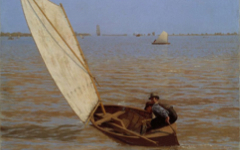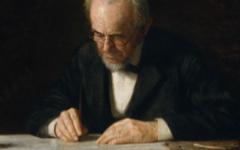Eakins’ The Champion Single Sculls (1871)

Eakins, The Champion Single Sculls or Max Schmitt in a Single Scull (1871) Oil on canvas. Metropolitan Museum of Art, New York
Click image to enlarge.
This masterpiece by an American artist depicting the end of a boat race has already been described by a lone art scholar as an expression of Eakins' own desire to succeed in art and how, even though the artist himself is depicted rowing in the background, Eakins primarily identifies with the figure in the foreground, Max Schmitt the champion.1 The moment appears to be when Schmitt, past the finish line, lets his scull glide smoothly on while Eakins, not part of the race, strains at the oars in the middle distance.
Click next thumbnail to continue
Henry Adams wrote about this picture in 2005 that the young Eakins "painted it at a time when he [Eakins] was intensely eager to become a champion like Schmitt but he had done nothing noteworthy enough to earn such a title." He added that the picture is "clearly in good part a self-portrait and an assertion of how Eakins wanted to be seen".2 Adams has even linked the moods and practices involved in rowing to those of Eakins' own efforts in painting. "Schmitt", he concludes "serves as a vehicle onto which Eakins projects his own anxieties and needs."
Click next thumbnail to continue
Adams, unaware that Eakins shares his technique with many earlier masters, fails to note that the long, thin oars are visual metaphors for long, thin paintbrushes dipped in paint. The water's surface, which Adams describes as "glassy smooth"3, is Eakins "canvas" as well as the mirror-like surface of his mind. Adams adds that Eakins in speaking "was quite skilful at playing with double meanings, and at seeming to say one thing while actually saying another."4 It was his way of making art too.
Click next thumbnail to continue
No-one, though, has ever noted before that Eakins who signed the painting on his scull under his self-portrait (left) suggests through that pun that the signed painting is a single skull, his own, and thus his mind. Hans Holbein made a similar reference in 1533 when he added an anamorphic skull to his portrait of two ambassadors. The skull is a "hollow bone" or "hohl-bein" in the German of his day.5
Click next thumbnail to continue
I find Adams' observations on target. He notes how odd it is that the champion looks melancholically down into the water while Eakins, the non-competitor, strains at the oars. It all makes sense when Eakins in his scull (or skull) is seen as the artist himself straining to paint the principal figure, his race-winning alter ego in the foreground. Schmitt, like Narcissus the legendary inventor of painting, looks down at his reflection in the water6 He also looks over his shoulder as artists do when painting their self-portraits in the mirror.
See conclusion below
Adams decides that the painting cannot have been intended as a mimetic representation of nature because the water does not reflect what it should. The wisps of cloud, for example, cannot be seen below nor reflections of the red and white bridges. The oars - which we now know are "paintbrushes" - have just sketched straight dark lines across Eakins' "canvas" while the clouds above seem to echo the shape of the scull and oars.6 Eakins, who was trained by Geröme in Paris, maintained a style that many describe as "realist" and somewhat out-dated for his time. Yet whatever one thinks of his craft, he had a good understanding of art's purpose and meaning and expresses it here clearly in his first masterpiece.7
More Works by Eakins
Notes:
1. Adams, Eakins Revealed: The Secret Life of an American Artist (Oxford University Press) 2005, p. 199
2. Adams, op. cit., pp. 199-200
3. Adams, op. cit., p. 198
4. Adams, op. cit., p. 200
5. Holbein's The Ambassadors is in the National Gallery, London. See Claude Gandelman, "The Semiotic of Signatures in Painting: A Peircian Analysis” in American Journal of Semiotics 3, No. 3, 1985, p. 84
6. Leon Alberti cited Narcissus as the legendary inventor of painting in his 1436 treatise, On Painting. Leon Battista Alberti, On Painting. ed. and parallel trans. Cecil Grayson. London: Phaidon, 1972, p. 2:26. Eakins' position in the center imagining the whole scene is now comparable to the reflection of Velazquez's king and queen (representing the artist) in the center of Las Meninas or of the artist himself in the convex mirror of Van Eyck's portrait of the Arnolfinis.
7. Adams also suggests that the painting expresses a way out of depression through physical exercise outdoors. His mother was deeply depressed at the time and is said to have been his inspiration. It is more likely, though, at this deep level that he is suggesting a way out for artists, depressed, stuck in a creative block and, like himself, unable to produce a masterpiece, a problem solved by this very painting. Eakins was now a champion.
Original Publication Date on EPPH: 10 Apr 2012. | Updated: 0. © Simon Abrahams. Articles on this site are the copyright of Simon Abrahams. To use copyrighted material in print or other media for purposes beyond 'fair use', you must obtain permission from the copyright owner. Websites may link to this page without permission (please do) but may not reproduce the material on their own site without crediting Simon Abrahams and EPPH.






